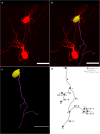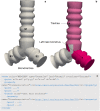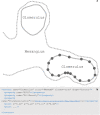A Comprehensive, FAIR File Format for Neuroanatomical Structure Modeling
- PMID: 34601704
- PMCID: PMC8975944
- DOI: 10.1007/s12021-021-09530-x
A Comprehensive, FAIR File Format for Neuroanatomical Structure Modeling
Abstract
With advances in microscopy and computer science, the technique of digitally reconstructing, modeling, and quantifying microscopic anatomies has become central to many fields of biological research. MBF Bioscience has chosen to openly document their digital reconstruction file format, the Neuromorphological File Specification, available at www.mbfbioscience.com/filespecification (Angstman et al., 2020). The format, created and maintained by MBF Bioscience, is broadly utilized by the neuroscience community. The data format's structure and capabilities have evolved since its inception, with modifications made to keep pace with advancements in microscopy and the scientific questions raised by worldwide experts in the field. More recent modifications to the neuromorphological file format ensure it abides by the Findable, Accessible, Interoperable, and Reusable (FAIR) data principles promoted by the International Neuroinformatics Coordinating Facility (INCF; Wilkinson et al., Scientific Data, 3, 160018,, 2016). The incorporated metadata make it easy to identify and repurpose these data types for downstream applications and investigation. This publication describes key elements of the file format and details their relevant structural advantages in an effort to encourage the reuse of these rich data files for alternative analysis or reproduction of derived conclusions.
Keywords: FAIR data; Morphological modeling; Neuroimaging; Neuromorphology; Neuron reconstruction; Vasculature reconstruction.
© 2021. The Author(s).
Conflict of interest statement
MBF Bioscience is a commercial entity, and the authors affiliated with them are company employees.
Figures













References
-
- Abrams, M. B., Bjaalie, J. G., Das, S., Egan, G. F., Ghosh, S. S., Goscinski, W. J., Grethe, J. S., Kotaleski, J. H., Wei Ho, E. T., Kennedy, D. N., Lanyon, L. J., Leergaard, T. B., Mayberg, H. S., Milanesi, L., Mouček, R., Poline, J. B., Roy, P. K., Strother, S. C., Tang, T. B., Tiesinga, P., Wachtler, T., Wójcik, D. K., & Martone, M. E. (2021). A standards organization for open and FAIR neuroscience: the International Neuroinformatics Coordinating Facility. Neuroinform. 10.1007/s12021-020-09509-0.
-
- Achanta S, Gorky J, Leung C, Moss A, Robbins S, Eisenman L, Chen J, Tappan S, Heal M, Farahani N, Huffman T, England S, Cheng ZJ, Vadigepalli R, Schwaber JS. A comprehensive integrated anatomical and molecular atlas of rat intrinsic cardiac nervous system. iScience. 2020;23(6):101140. doi: 10.1016/j.isci.2020.101140. - DOI - PMC - PubMed
-
- Angstman, P. J., Tappan, S. J., Sullivan, A. E., Thomas, G. C., Rodriguez, A., Hoppes, D. M., Abdul-Karim, M. A., Heal, M. L., Glaser, J.R. (2020). Neuromorphological File Specification (4.0). Neuromorphological File Specification. Retrieved March 23, 2020, from www.mbfbioscience.com/filespecification
-
- Ascoli GA, Donohue DE, Halavi M. NeuroMorpho.Org: a central resource for neuronal morphologies. Journal of Neuroscience. 2007;27(35):9247–9251. doi: 10.1523/jneurosci.2055-07.2007. - DOI - PMC - PubMed
Publication types
MeSH terms
Grants and funding
LinkOut - more resources
Full Text Sources

